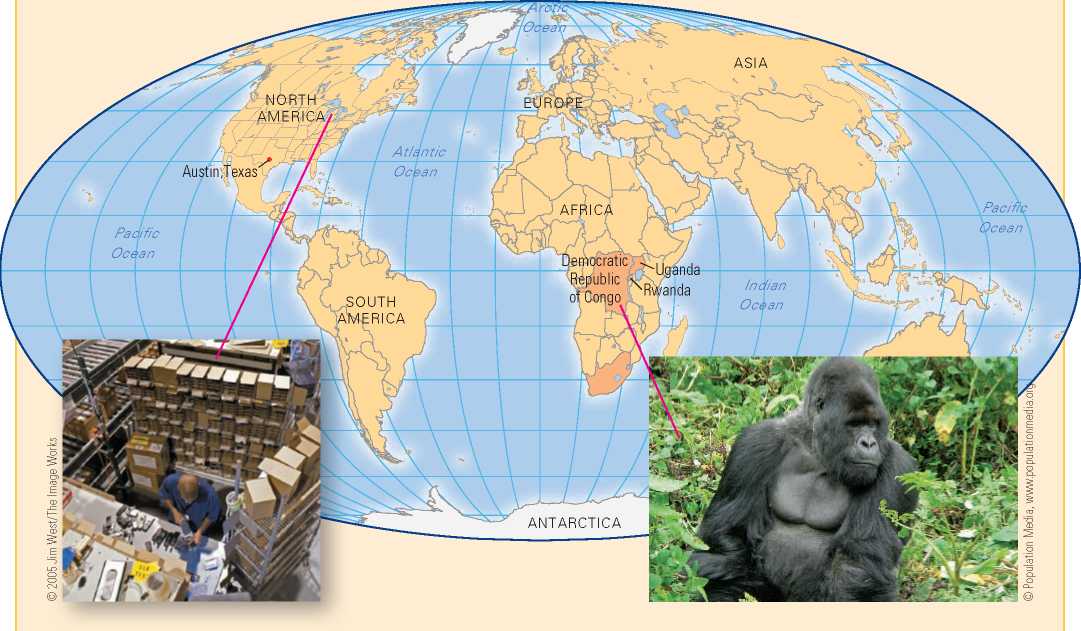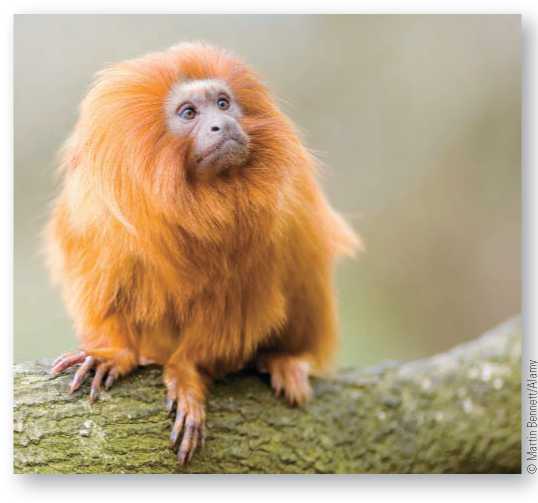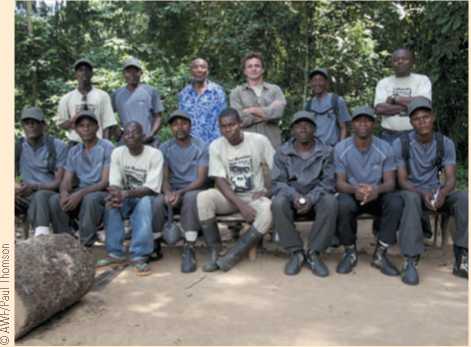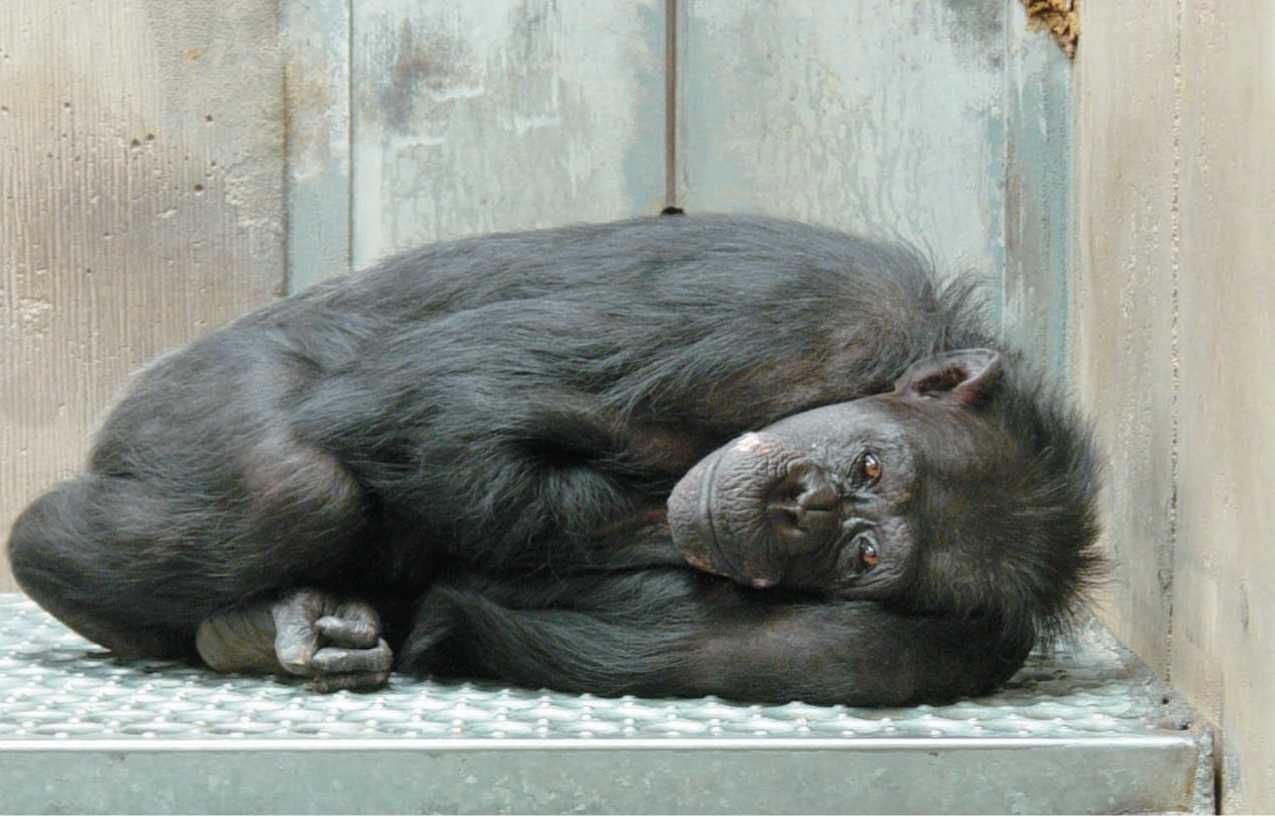The above survey of living primates illustrates the diversity of our closest living relatives. To ensure that they will continue to share the planet with us, primate conservation has become an issue of vital importance. Nearly 50 percent of the known primate species and subspecies face extinction in the next decade.33
In Asia, the statistics are even more alarming, with more than 70 percent of species threatened and at least 80 percent at risk in Indonesia and Vietnam. Included among them are all of the great apes, as well as such formerly widespread and adaptable species as rhesus macaques. In the wild these animals are threatened by habitat destruction caused by
Globalscape

Gorilla Hand Ashtrays?
Tricia, a 20-year-old from Austin,
Texas, blogs: "At that party did you meet the guy from South Africa that looked like an exact replica of Dave Matthews (only skinnier) who was talking about gorilla hand ashtrays?”® The unnamed guy was talking about one of the many real threats to gorillas in the wild. With no natural enemies, human actions alone are responsible for the shrinking population of gorillas in their natural habitats in Rwanda, Uganda, and the Democratic Republic of Congo. Despite conservation work, begun by the late primatologist Dian Fossey, who pioneered field studies of the gorillas in the 1970s, gorilla hand ashtrays and heads remain coveted souvenirs for unsavory tourists. A poacher can sell these body parts and the remaining bushmeat for a handsome profit.
Today, not only do logging and mining in gorilla habitats destroy these forests, but roads make it easier for poachers to access the gorillas. Local governments of Rwanda and Uganda in partnership with the Fossey Fund and the Bush Meat Project have set up poaching patrols and community partnerships to protect the endangered gorillas. Thousands of miles away, Tricia and her friends can also help by recycling their cell phones. The mineral coltan that is found in cell phones is mined primarily from gorilla habitats in the Democratic Republic of Congo. Recycling, as pictured here in a Michigan cell phone recycling plant, will reduce the amount of new coltan needed.
Global Twister Encouraging recycling of cell phones and discouraging poaching both will impact gorilla survival. How would you go about convincing average cell phone users or poachers to change their habits or livelihood to protect endangered gorillas?
®http://profile. myspace. com/ index. cfm? fuseaction=user. viewprofile&friendid=40312227. (accessed July 3, 2006)
Economic development (farming, lumbering, cattle ranching, rubber tapping), as well as by hunters and trappers who pursue them for food, trophies, research, or as exotic pets. Primatologists have long known the devastating effects of habitat destruction through slash-and-burn agriculture.
Further, it is not just traditional practices, such as the burning and clearing of tropical forests, that are destroying primate habitats. War also impacts primate habitats significantly, even after a war has ended. Hunters may use the automatic weapons left over from human conflicts in their pursuit of bushmeat. Also, because monkeys and apes are so closely related to humans, they are regarded as essential for biomedical research. While most primates in laboratories are bred in captivity, an active trade in live primates still threatens their local extinction. Globalization also exerts a profound impact on local conditions. This chapter’s Globalscape illustrates how cell phones are impacting gorilla habitats and the survival of this species.
Because of their vulnerability, the conservation of primates has become a matter of urgency. Traditional conservation efforts have emphasized habitat preservation above all else, but primatologists are now expanding their efforts to include educating local communities and discouraging the hunting of primates for food and medical purposes. Some primatologists are even looking for alternative economic strategies for local peoples so that human and primate populations can return to the successful coexistence that prevailed before colonialism and globalization contributed to the destabilization of tradition homelands. This chapter’s Anthropology Applied looks at these economic development efforts in the Democratic Republic of Congo.
In direct conservation efforts, primatologists work to maintain some populations in the wild, either by establishing preserves where animals are already living or by moving populations to suitable habitats. These approaches require constant monitoring and management to ensure that sufficient space and resources remain available. As humans encroach on primate habitats, translocation of primates to protected areas is an viable strategy for primate conservation, and the field studies by primatologists for such relocations are invaluable.
For example, when the troop of free-ranging baboons that primatologist Shirley Strum had been studying for fifteen years in Kenya began raiding people’s crops and garbage on newly established farms, she was instrumental in successfully moving this troop and two other local troops—130 animals in all—to more sparsely inhabited country 150 miles away. Knowing their habits, Strum was able to trap, tranquilize, and transport the animals to their new home while preserving the baboons’ vital social relationships. Strum’s careful work allowed for a smooth transition. With social relations intact, the baboons did not abandon their new homes nor did they block the transfer of new males, with their all-important knowledge of local resources, into the troop. The success of her effort, which had never been tried with baboons, proves that translocation is a realistic technique for saving endangered primate species. However, this conservation effort depends first on available land, where preserves can be established to provide habitats for endangered primates.
A second strategy has been developed to help primates that have been illegally trapped—either for market as pets or for biomedical research. This approach involves returning these recovered animals to their natural habitats. Researchers have established orphanages in which specially trained human substitute mothers support the young primates so that they can gain enough social skills to return to living with their own species.
A third strategy to preventing primate extinction is to maintain breeding colonies in captivity. These colonies encourage psychological and physical well-being, as well as reproductive success. Primates in zoos and laboratories do not successfully reproduce when deprived of such

Because of their exceptional beauty, golden lion tamarin monkeys (or golden marmosets) have been kept as pets since colonial times. More recently, they have also been threatened by development, as they reside in the tropical forest habitats around the popular tourist destination of Rio de Janeiro, Brazil. A major conservation effort, initiated in the 1980s to save these monkeys, included planting wildlife corridors to connect the remaining forest patches and releasing animals bred in captivity into these newly created environments. Today live wild births have increased steadily, and the golden lion tamarin population is recovering from the threat of extinction.
Amenities as opportunities for climbing, materials for nest building, others with whom to socialize, and places for privacy. While such features contribute to the success of breeding colonies in captivity, ensuring the survival of our primate cousins in suitable natural habitats is a far greater challenge that humans must meet in the years to come.
The good news is the results of conservation efforts are beginning to show. For example, due to intense conservation programs, the population size of the mountain gorilla (Gorilla beringei beringei) is increasing, even with the political chaos of Rwanda, Uganda, and the Democratic Republic of Congo. Western lowland gorilla populations (Gorilla gorilla) are also on the rise. Similarly, tamarin monkey populations in Brazil have stabilized despite being on the brink of extinction thirty years ago, demonstrating the effectiveness of the conservation initiatives put into place. According to primatologist Sylvia Atsalis, “The presence alone of scientists has been shown to protect primates, acting as a deterrent to habitat destruction and hunting. The more people we can send, the more we can help to protect endangered primates.”34
Anthropology Applied


The African Wildlife Foundation team in the Congo Heartland. The Lomako Conservation Research Center provides jobs for local families and serves as an anchor for research, conservation, and microenterprise activities in the largely undisturbed Lomako Forest while also securing the habitat of the bonobo, a rare great ape that lives in the Lomako Forest.
Under the leadership of Belgian prima-tologist Jef Dupain, the African Wildlife Foundation has embarked on a number of projects to support the continued survival of bonobos and mountain gorillas in the Democratic Republic of Congo (DRC). Called the Congo Heartland Project, this work is designed to support the local human populations devastated by a decade of civil war in the Congo itself as well as the impact of the massive influx of refugees from war and genocide in neighboring Rwanda.
The rich rainforest habitats of the tributaries of the mighty Congo River in the DRC are the only natural habitats for bonobos in the world. Mountain gorillas can be found in the DRC and in neighboring Uganda and Rwanda. Primatological fieldwork thrived in sites established during the 1970s until the mid-1990s when war and genocide led to the forced removal of primatologists. While many left the region, Dupain stayed and monitored the kinds of bushmeat brought into the markets in Kinshasa. With the human population desperate and starving and the poachers armed with automatic weapons outnumbering the few park rangers charged with protecting the
Great apes, many primates perished. Since a fragile peace was achieved in 2003, initiatives of the Congo Heartland Project have been reestablished, including involving local communities in agricultural practices to protecting the Congo River and its tributaries and to preserve their precious animal populations.
Congo Heartland Project initiatives typically empower local communities in development efforts using a participative, interactive, and transparent approach. For example, a range of different ethnic groups, including those who are marginalized such as Pygmies and women, met with local authorities to reestablish the management policies of Dupain's field site (the Lomako Yokokala Faunal Reserve) as it reopened for researchers and ecotourists. Forty percent of the income generated in park revenues is to return to the local communities. According to Dupain, success for these projects is defined as follows:
Local communities take part in decision making on how the protected area will be managed, on how revenue will be shared, and as a result, local communities take up the defense of their protected area. In time, densities of bonobo, bongo, forest elephant, Congo peacock, leopard, Allen's swamp monkey, black and white colobus, and many others will increase, more tourists and researchers will come and will be willing to pay for this environmental service, local communities will have increased access to education, medical treatment, electricity, clean water. . . the list goes on.
Mange Bofaso put it best: "In Katanga they have diamonds. Here in Lomako, we have bonobos.”®
The Congo Heartland Project also includes encouraging a variety of alternative economic practices in communities bordering existing wildlife preserves. For example, around the Virunga National Park, home to the endangered mountain gorilla, Congolese Enterprise Officer Wellard Makambo encourages and monitors bee keeping and a women's mushroom farm collective. He also advises members of a conflict resolution team dealing with gorillas that have left the wildlife preserve to raid human crops. Local communities require reassurance and restitution, while gorillas need to be returned safely to the park. When Makambo made his first trip back to the Bukima Ranger Station after the war, he wrote,
While I was standing on the hill surveying the amazing Bukima view I felt like a mighty silverback gorilla looking at his bountiful bamboo kingdom. One whose life would be hopeless if this kingdom is destroyed. I tried to measure the effects of the war on people and on our activities and projects.
It was tough getting my head around it: how to re-start things when you realise effort alone is not sufficient. You need stability as well, which is slowly coming back to this area.
These economic development projects are playing a crucial role in restoring the stability in the region required for the continued survival of bonobos and mountain gorillas. 35 36
1. Does knowing more about the numerous similarities among the primates including humans motivate you personally to want to meet the challenge of preventing the extinction of our primate cousins? How would you go about doing this?
2. Considering some of the trends seen among the primates, such as increased brain size or reduced tooth number, why is it that we cannot say that some primates are more evolved than others? What is wrong with the statement that humans are more evolved than chimpanzees?
3. Two systems exist for dividing the primate order into suborders because of difficulties with classifying tarsiers.
Should classification systems be based on genetic relationships or based on the biological concept of grade? Is the continued use of the older terminology an instance of inertia or a difference in philosophy? How do the issues brought up by the “tarsier problem” translate to the hominoids?
4. What aspects of mammalian primate biology do you see reflected in yourself or in other humans you know?
5. Many primate species are endangered today. What human factors are causing endangerment of primates, and how can we prevent the extinction of our closest living relatives?
De Waal, F. B.M. (2001). The ape and the sushi master. New York: Basic.
This masterful discussion of the presence of culture among apes moves this concept from an anthropocentric realm and ties it instead to communication and social organization. In an accessible style, Frans de Waal, one of the world’s foremost experts on bonobos, demonstrates ape culture while challenging human intellectual theories designed to exclude animals from the “culture club.”
De Waal, F. B.M. (2003). My family album: Thirty years of primate photography. Berkeley: University of California Press. This book expertly blends scientific theories with photographs. De Waal illustrates the emotional intelligence, personality, and diverse social behaviors of the apes and Old World monkeys he has encountered in the field.
Fossey, D. (1983). Gorillas in the mist. Burlington, MA: Houghton Mifflin.
The late Dian Fossey is to gorillas what Jane Goodall is to chimpanzees. Fossey devoted years to the study of gorilla behavior in the field. This book is about the first thirteen years of her study; as well as being readable and informative, it is well illustrated.
Galdikas, B. (1995). Reflections on Eden: My years with the orangutans of Borneo. New York: Little, Brown.
Birute Galdikas is the least known of the trio of young women sent by Louis Leakey in 1971 to study apes in the wild. Her work with the orangutans of Borneo, however, is magnificent. In this book she presents rich scientific information as well as her personal reflections on a life spent fully integrated with orangutans and the culture of Borneo.
Goodall, J. (1990). Through a window: My thirty years with the chimpanzees of Gombe. Boston: Houghton Mifflin.
This fascinating book is a personal account of Jane Goodall’s early experiences studying wild chimpanzees in Tanzania. A pleasure to read and a fount of information on the behavior of these apes, the book is profusely illustrated as well.
Goodall, J. (2000). Reason for hope: A spiritual journey. New York: Warner.
Jane Goodall’s memoir linking her monumental life’s work with the chimpanzees of Gombe to her spiritual convictions. She clearly states her commitment to conferring on chimpanzees the same rights and respect experienced by humans through the exploration of difficult topics such as environmental destruction, animal abuse, and genocide. She expands the concept of humanity while providing us with powerful reasons to maintain hope.
Rowe, N., & Mittermeier, R. A. (1996). The pictorial guide to the living primates. East Hampton, NY: Pogonias.
Filled with dynamic photographs of primates in nature, this book also provides concise descriptions (including anatomy, taxonomy, diet, social structure, maps, and so on) for 234 species of primates. The book is useful for students and pri-matologists alike.
Challenge Issue Biological similarities among humans, apes, and Old World monkeys have led to the extensive use of nonhuman primate species in biomedical research aimed at preventing or curing disease in humans. These research animals are subjected to procedures that would be considered morally questionable if done on humans. Mickey, for example, was one of the hundreds of chimps who spent decades of her life alone in a concrete-and-steel windowless cage in a private research facility in New Mexico run by Frederick Coulston. After years of testing the effects of various infectious diseases, cosmetics, drugs, and pesticides on chimps like Mickey, the Coulston laboratory finally closed in 2002 when government research funding was withdrawn due to repeated violations of the Animal Welfare Act. But after years of abuse and neglect, research chimpanzees lack the skills to participate in chimpanzee social life. Furthermore, research animals have often been infected with deadly diseases such as HIV or hepatitis and cannot be released into the wild. Fortunately, Mickey and the other research chimps were given sanctuary through Save the Chimps, one of several organizations that rescue research animals. The human challenge for the future will be to use our abundant intelligence and social conscience, traits that our closest relatives also possess, to make the development of alternative research methods a top priority, so that nonhuman primates no longer have to be victimized by biomedical research.

Courtesy of Save the Chimps, the world’s largest sanctuary for rescued chimpanzees; Www. savethechimps. org




 World History
World History









